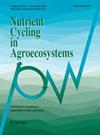有机改良剂氮肥替代值的测定与预测
IF 2.7
3区 农林科学
Q2 SOIL SCIENCE
引用次数: 0
摘要
氮肥替代值(NFRV)量化了有机改进剂作为氮肥的价值,通常定义为有机肥N替代矿肥N的程度。NFRV可以通过比较矿肥和有机肥在相同施氮量下作物对氮的吸收,或者通过比较两种肥料获得相同作物氮吸收所需的施氮量来计算。目前,nfrv主要用于动物粪便,而其他有机废物产品可能在未来成为肥料产品。本研究以春小麦为研究对象,通过盆栽试验(1)评估不同有机改进剂的NFRVs;(2)比较等量施氮和等量吸收氮的NFRVs;(3)评估哪些产品特性可以解释观察到的变化。观察到的NFRVs在6.2至78.8%之间变化,生食物垃圾的NFRVs值最低,鱼粉的NFRVs值最高。在等量施氮条件下(平均为6.9%点),nfrv被高估,在高施氮条件下(9.0%点),nfrv被高估。因此,NFRVs应根据从有机和矿物肥料中吸收相等的氮来计算。有机肥氮浓度最能解释nfrv的变异(r2 = 0.86)。这些发现为有机废物流作为有机肥料价值的巨大变化提供了有价值的见解,并可以支持可持续施氮率的决策,以增加作物对氮的吸收并减少对环境的氮损失。本文章由计算机程序翻译,如有差异,请以英文原文为准。
Nitrogen fertilizer replacement values of organic amendments: determination and prediction
Abstract The nitrogen fertilizer replacement value (NFRV) quantifies the value of organic amendments as a nitrogen (N) fertilizer, and is commonly defined as the extent to which organic fertilizer N can replace mineral fertilizer N. NFRVs can be calculated by comparing the crop N uptake from equal N application rates of mineral and organic fertilizer, or by comparing the N rates of both fertilizers needed to obtain equal crop N uptake. Currently, NFRVs are mainly known for animal manure, whereas other organic waste products may become available as fertilizer products in the future. In this study, a pot experiment with spring wheat was performed to (1) assess NFRVs of a range of organic amendments; (2) compare NFRVs based on equal N application with NFRVs based on equal N uptake; and (3) assess which product characteristics explain observed variation. Observed NFRVs varied between 6.2 and 78.8%, with the lowest value for raw food waste and the highest for fishmeal. NFRVs were overestimated when calculated based on equal N application rate (with on average 6.9% point), and more so at high N application rate (9.0% point). NFRVs should therefore be calculated based on equal N uptake from organic and mineral fertilizers. Nitrogen concentration of the organic fertilizer provided the best explanation of variation observed in NFRVs (R 2 = 0.86). These findings give valuable insights into the large variation in value of organic waste streams as organic fertilizer and can support decisions on sustainable N application rates, to increase crop N uptake and reduce N losses to the environment.
求助全文
通过发布文献求助,成功后即可免费获取论文全文。
去求助
来源期刊

Nutrient Cycling in Agroecosystems
农林科学-土壤科学
CiteScore
5.90
自引率
3.20%
发文量
61
审稿时长
4.5 months
期刊介绍:
Nutrient Cycling in Agroecosystems considers manuscripts dealing with all aspects of carbon and nutrient cycling as well as management and examining their effect in ecological, agronomic, environmental and economic terms. Target agroecosystems include field crop, organic agriculture, urban or peri-urban agriculture, horticulture, bioenergy, agroforestry, livestock, pasture, and fallow systems as well as their system components such as plants and the fertility, chemistry, physics or faunal and micro-biology of soils. The scale of observation is the cycles in the soil-plant-animal system on or relevant to a field or watershed level as well as inputs from or losses to the anthroposphere, atmosphere and hydrosphere. Studies should thus consider the wider system in the examination of cycling and fluxes in agroecosystems or their components. These may include typically multi-year field observations, farm gate budgets, watershed studies, life cycle assessments, enterprise and economic analyses, or regional and global modeling. Management objectives may not only include the maximization of food, fiber and fuel production, but also its environmental and economic impact. The results must allow mechanistic conclusions of broad applicability and distinguish itself from empirical results or case studies of merely local or regional importance. If unsure whether a study fits into this scope, please contact the editor with a brief inquiry before manuscript submission.
 求助内容:
求助内容: 应助结果提醒方式:
应助结果提醒方式:


